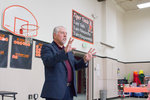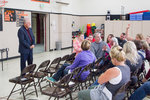

One month after Centralia School District broke ground on new construction at Fords Prairie Elementary School, parents gathered in the school’s gym this week to voice frustration that their children may not actually get to attend classes at the new facility.
The Fords Prairie PTO’s monthly meeting on Tuesday evening had a packed house with Superintendent Mark Davalos present to answer questions.
“We can’t get any direct answers from the district,” said Monica Laufenberg, who has four children in the district. Laufenberg said before the meeting that many parents felt lied to, a sentiment that repeatedly echoed throughout Davalos’ hour-long Q&A with parents.
After the district completes construction on its two new elementary schools — which will replace Fords Prairie and Jefferson Lincoln — all five elementary schools are switching to a K-6 model.
“They are telling kids if you go to Fords Prairie, you will get a new school,” Laufenberg said. “That’s not true.”
Currently, Centralia School District has three residency zones in the district, which determine which school a child will attend.
However, when the five elementary schools switch to a K-6 model, boundary lines will shift from three zones to five zones, moving between 20 and 30 percent of students from one school to another.
Laufenberg was one of about 10 parents who voiced concerns at a packed PTO meeting on Tuesday evening.
“There are some of us who have purchased our homes with the idea our kids were going to a certain school,” said one mother, whose son attends Edison.
There are five elementary schools in Centralia School District — Edison, Fords Prairie, Jefferson Lincoln, Oakview and Washington. Edison, Fords Prairie and Jefferson Lincoln house K-3, while Oakview and Washington house fourth through sixth grades.
“Three-fifths of our population are not going to be in those new schools,” Davalos said after the meeting. “They are going to be at the other three. We’re not doing that to punish them. It’s happening as a result of we are improving two schools, hopefully all other three in the future. There’s no malinent there. It’s just a result of finally (making) a decision to make improvements.”
In total, there are 1,930 kindergarten through sixth grade students in the district.
“We will divide that among five schools,” Davalos said. “We know that the two new schools will hold anywhere from 425 to 450 (students). We’re not going to try to pack each school to its full capacity. We are going to try to leave a little room for some flexibility. That will tell us how many spaces we get to use at the other three (schools), too.”
Davalos said he will not know how many students the other three elementary schools will hold until September, when a boundary committee begins its work.
“We are still in conversation about what we want to set as a target for each school,” Davalos said. “We have to determine where to put special ed programs, childcare classrooms, so that might change how many kids we put in school a, b, or c, based on other programs that we put there.”
Davalos said the boundary committee will “probably” consist of at least one parent and one teacher from each of the five geographical areas and the five principals. The committee will start its work in September and finish by December.
“We will make recommendations for the board to approve boundaries in January (2019),” Davalos said. “But by then, people will have seen what those recommendations are going to be.”
This shift is part of a $74 million bond that passed in 2017 to replace Fords Prairie and Jefferson Lincoln with two new K-6 facilities and to give Centralia High School a full, like-new remodel.
“We hope, knowing those projections for the next five to ten years, that those boundaries will last for some time,” Davalos said. “[The district hopes] that they won’t be boundaries that will be changed in a couple of years. They will be boundaries for the next five or ten years.”
In addition to concerns over boundary lines, parents expressed hesitance over kindergarten and sixth-grade students playing on the same playground or using the same bathrooms. A common suggestion was to keep the new elementary schools as K-3 facilities.
“Even though that probably could be a discussion, I doubt that that would happen,” Davalos said. “We are so far along in our design and in groundbreaking that to go back and start changing classrooms and bathrooms and the rest of that is going to be costly. We are probably, if not already, well past that line of no return, almost there. This decision has been alive for more than a year now. This is probably a little late to think about changing that.”
Davalos said that although kindergarten and sixth grade students will be in the same building, they will not interact on the playground.
In addition, students in the new facilities will be separated by floors, with K-3 on the first floor and fourth through sixth grade on the second floor. In Edison, Oakview and Washington, students will be separated by wings.